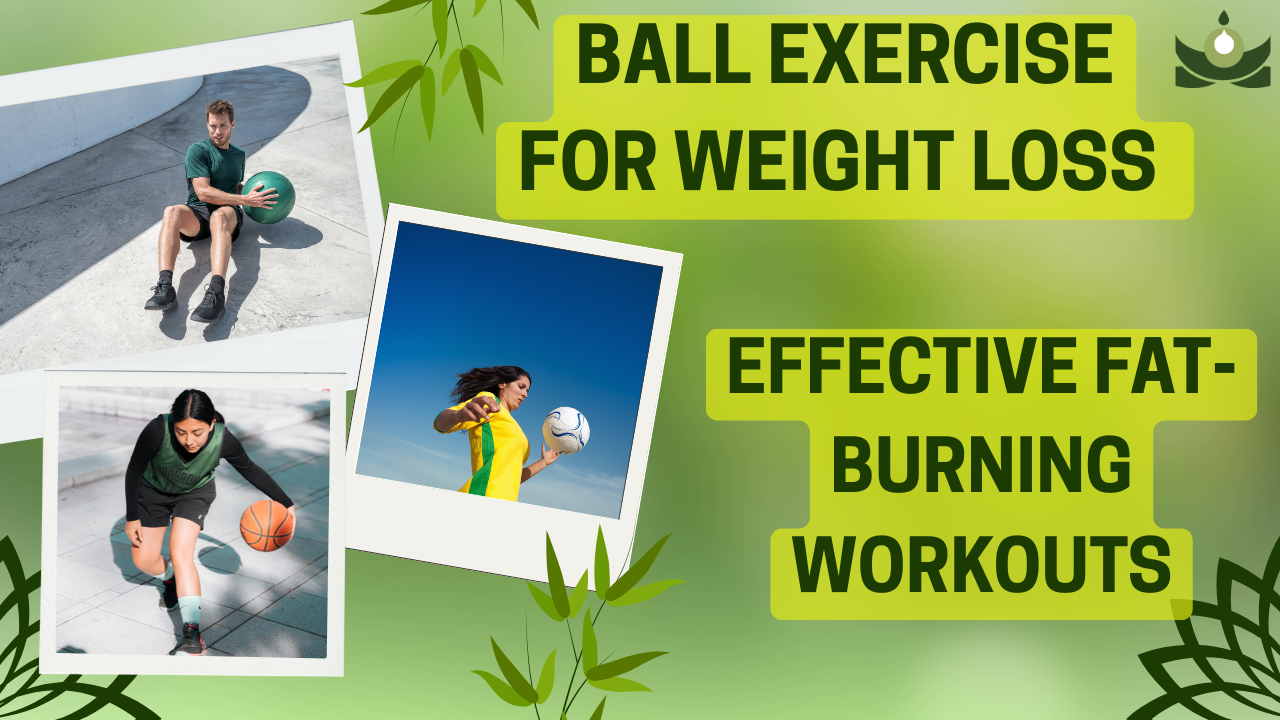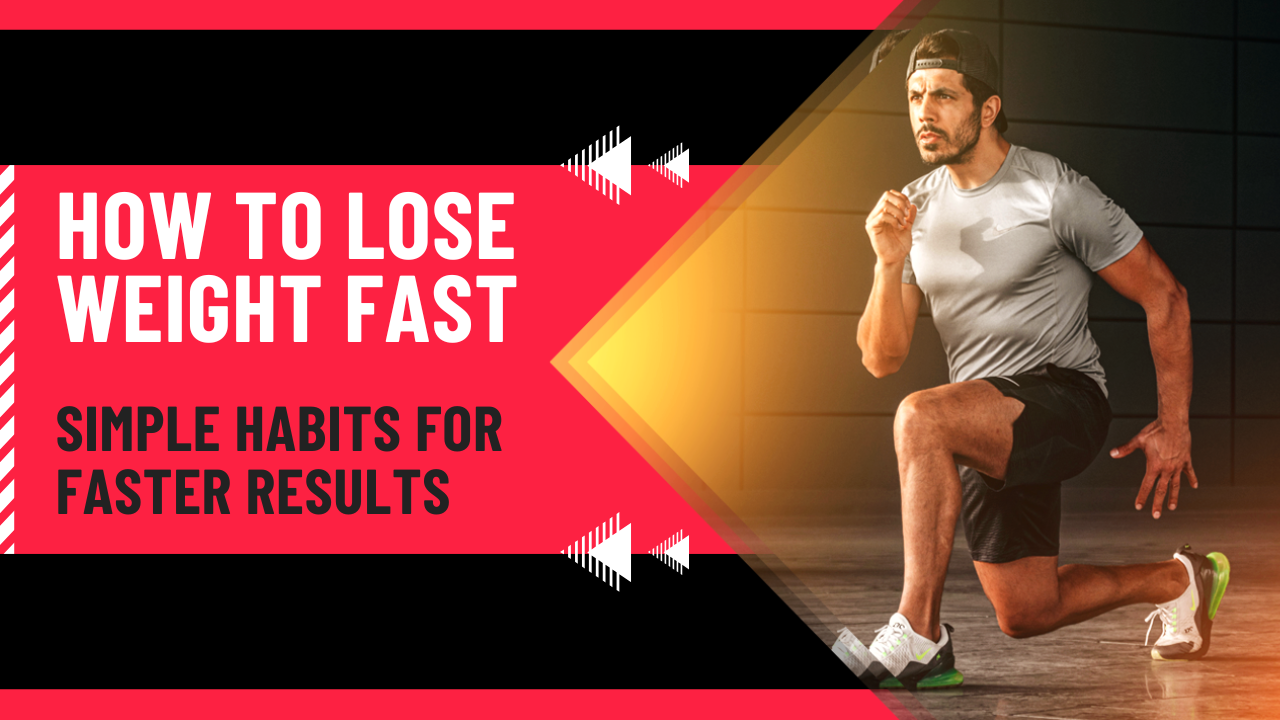Ball exercise for weight loss is a fun and highly effective way to burn calories, tone muscles, and improve overall fitness. Using a stability ball, medicine ball, or exercise ball provides a full-body workout that targets core strength while engaging multiple muscle groups at once. Unlike traditional gym routines, ball workouts are low-impact and suitable for all fitness levels.
Adding a ball exercise for weight loss routine to your schedule increases calorie expenditure and improves posture. The unstable surface of a fitness ball forces the body to stabilize, activating deep abdominal muscles and enhancing fat burn. Whether performed at home or in a gym, these exercises can be adapted for beginners or advanced fitness enthusiasts.
Incorporating ball exercises into your daily plan helps break workout monotony. From crunches to planks and squats, a ball exercise for weight loss plan not only promotes fat loss but also improves flexibility, balance, and muscle endurance.
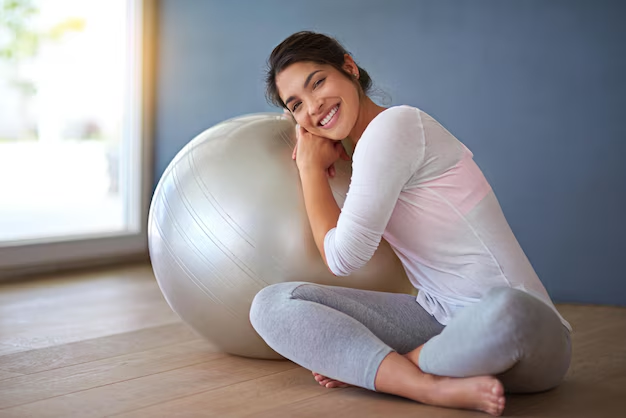
What is Ball Exercise for Weight Loss
Ball exercise for weight loss involves performing workouts using an exercise ball (stability ball or medicine ball) to burn fat and strengthen muscles. The ball’s instability engages core muscles, making even simple moves more effective.
During a ball exercise for weight loss routine, exercises like planks, bridges, and squats are intensified because the body works harder to maintain balance. This extra effort increases heart rate and calorie burn, which supports fat reduction.
Unlike heavy gym equipment, a fitness ball is lightweight, inexpensive, and versatile. A ball exercise for weight loss session can be done at home or outdoors, making it perfect for busy individuals seeking practical yet powerful workouts.
Why Choose Ball Exercise for Weight Loss
The main reason to choose a ball exercise for weight loss is its ability to engage multiple muscle groups simultaneously. The unstable surface activates stabilizer muscles, promoting more calorie burn than static exercises.
A ball exercise for weight loss routine also improves balance, coordination, and flexibility. These benefits not only help in weight management but also reduce the risk of injuries in daily activities.
Furthermore, ball workouts are low-impact, making them ideal for people who want to lose weight without putting excessive stress on joints. This makes ball exercise for weight loss suitable for all ages and fitness levels.
When to Do Ball Exercise for Weight Loss
The best time for ball exercise for weight loss depends on your lifestyle. Many prefer morning sessions to kickstart metabolism and burn calories throughout the day. Morning workouts also enhance mood and energy levels.
If mornings are not feasible, afternoon or evening routines are equally effective. Performing ball exercise for weight loss after work can relieve stress and prevent late-night snacking.
Aim for at least 30–45 minutes of ball workouts, 4–5 days a week. Consistency is key to achieving noticeable fat loss through a structured ball exercise for weight loss plan.
How Does Ball Exercise Help with Weight Loss
Ball exercise for weight loss works by combining strength training with cardiovascular effort. Movements on an unstable ball engage core muscles, increase calorie expenditure, and improve metabolism.
The instability forces your body to use more energy to maintain balance. This increased energy demand during a ball exercise for weight loss session promotes fat burning, even after the workout ends.
Additionally, these exercises improve muscle tone, which raises resting metabolic rate. Over time, consistent ball exercise for weight loss sessions lead to sustainable fat loss and better body composition.
Top Tips for Ball Exercise for Weight Loss
Ball Squats for Full-Body Fat Burn
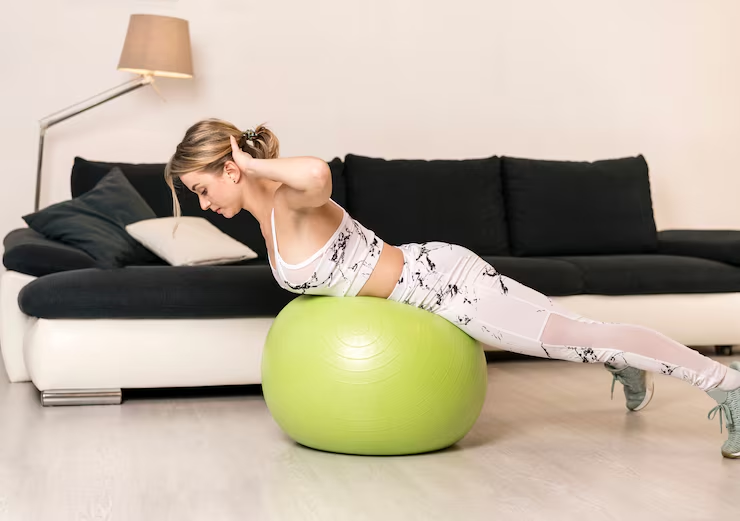
Ball squats are a highly effective exercise that engages multiple muscle groups at once while supporting proper posture. To begin, place a stability ball securely between your lower back and a sturdy wall. Position your feet shoulder-width apart and slightly forward for balance. Slowly lower your body by bending your knees into a squat position while keeping your chest lifted and core muscles tight. The ball allows smooth movement and provides support, making this exercise suitable for all fitness levels.
The stability ball helps maintain spinal alignment and reduces pressure on the knees, making ball squats safer than traditional squats. By performing 12–15 repetitions per set, you target your quads, hamstrings, glutes, and core simultaneously. As your strength improves, gradually increase the number of sets or add a slight hold at the bottom for extra intensity. Controlled breathing and steady movement ensure proper engagement of each muscle group.
In a ball exercise for weight loss routine, ball squats help build lean muscle in the thighs, glutes, and core, which raises your resting metabolism. Lean muscle burns more calories even when you are not exercising, making this a powerful fat-burning move. To intensify calorie burn, you can hold light dumbbells or add a small jump at the top of each squat. Consistency will lead to improved endurance and toned lower body muscles.
Benefits: Strengthens quads, hamstrings, glutes, and core; boosts metabolism; improves balance and posture; enhances calorie expenditure.
Ingredients/Tools: A stability ball for back support, optional light dumbbells to increase resistance, supportive shoes for stability, and a non-slip surface to avoid sliding.
Plank Holds on the Ball
Plank holds on a stability ball are an advanced variation of the classic plank that delivers deep core engagement and improved balance. To perform this exercise, place your forearms firmly on a stability ball while extending your legs straight behind you in a standard plank position. Ensure your elbows stay directly beneath your shoulders and your feet are hip-width apart for stability. This setup challenges your body to maintain balance, activating more muscles than a regular floor plank.
As you hold the position, focus on forming a straight line from your head to your heels. Engage your abdominal muscles, glutes, and lower back to prevent your hips from sagging or lifting too high. Start with a 20-second hold and gradually work up to 60 seconds as your strength improves. Proper breathing and steady concentration are key to maintaining correct form and maximizing results.
Unlike a standard plank, the ball’s instability forces your core muscles to work harder to maintain balance, significantly increasing calorie burn. This move strengthens the entire midsection, including the transverse abdominis and lower back. Over time, this leads to a tighter waistline and improved posture. Adding gentle forward and backward rolls while holding the plank can increase difficulty and fat-burning potential.
Benefits: Deep core activation, burns stubborn belly fat, enhances stability and balance, strengthens shoulders and back.
Ingredients/Tools: Stability ball for forearm support, yoga or exercise mat to protect elbows and knees, and comfortable workout shoes.
Ball Pass Crunches
Ball pass crunches combine core strength and coordination for maximum fat burn. Start by lying flat on your back with your legs extended and a stability ball held in your hands. Lift your arms and legs simultaneously, passing the ball from your hands to your feet. Lower both arms and legs toward the floor without touching it, then bring them back up to pass the ball again. Perform 10–15 passes per set.
This dynamic exercise engages not only the rectus abdominis but also the inner thighs, making it an effective calorie-burning move in a ball exercise for weight loss plan. The constant passing motion keeps your heart rate elevated, increasing metabolism and fat loss. Over time, it improves coordination and flexibility in the hips and lower back.
Benefits: Sculpts abs, tones inner thighs, improves coordination, and boosts calorie expenditure.
Ingredients/Tools: Stability ball or medicine ball (light to moderate weight), non-slip exercise mat, and breathable workout clothes for comfortable movement.
Push-Ups on the Ball
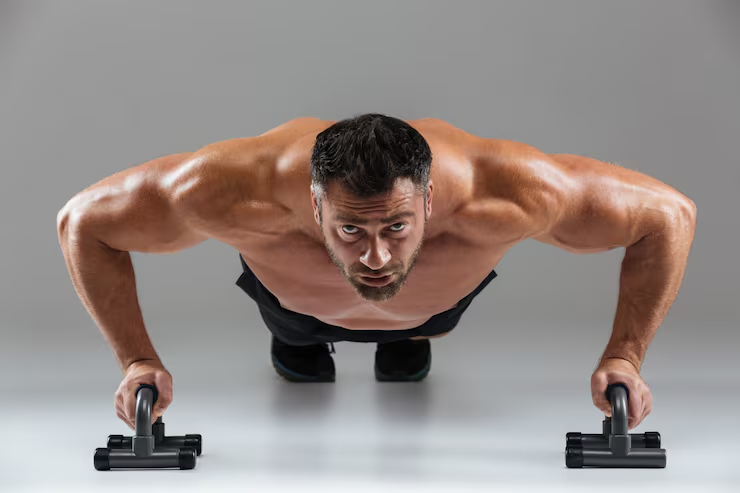
Push-ups with a stability ball elevate the classic upper-body exercise to a new level. Place your hands or feet on the ball depending on your skill level. Beginners can start with hands on the ball for added support, while advanced users can place their feet on the ball to challenge balance. Perform slow, controlled push-ups while keeping your core tight and back straight.
The instability of the ball activates chest, shoulders, arms, and core more than traditional push-ups. This increased muscle engagement results in greater calorie burn and improved upper-body strength. By elevating the feet on the ball, the exercise becomes more challenging and effective for fat loss.
Benefits: Strengthens chest, shoulders, triceps, and core; improves balance and coordination; raises heart rate for greater fat burning.
Ingredients/Tools: Stability ball for hand or foot placement, non-slip mat to prevent sliding, and optional wrist wraps for extra joint support.
Ball Bridges for Glute Activation
Ball bridges target the glutes, hamstrings, and lower back while improving core stability. Begin by lying on your back with knees bent and feet resting on the ball. Push through your heels to lift your hips off the floor until your body forms a straight line from shoulders to knees. Lower slowly and repeat for 12–15 reps per set.
This move enhances calorie burn by activating large lower-body muscles. Strengthening the glutes improves posture, reduces lower back pain, and contributes to better performance in daily activities. Adding a single-leg variation increases the challenge and accelerates fat loss.
Benefits: Tightens and lifts glutes, tones hamstrings, strengthens core, and burns calories by engaging large muscle groups.
Ingredients/Tools: Stability ball for foot placement, exercise mat for back support, and resistance bands (optional) for added tension.
Medicine Ball Slams
Medicine ball slams are an intense full-body exercise that combines strength training with cardio for rapid calorie burn. Begin by standing with your feet shoulder-width apart, holding a medicine ball securely overhead. Keep your core tight and knees slightly bent to protect your lower back. Using controlled force, slam the ball straight down to the ground as hard as possible, engaging your arms, shoulders, and core throughout the movement. Catch the ball on the rebound or retrieve it quickly to maintain a steady rhythm.
This explosive action elevates your heart rate and activates multiple muscle groups, including the chest, shoulders, back, abs, and legs. Perform the slams continuously for 20–30 seconds per set, aiming for three to five sets. As your strength improves, you can increase intensity by using a heavier ball or shortening rest periods. Always keep your spine neutral and move with power for maximum effect.
This explosive movement elevates heart rate, improves upper-body strength, and boosts metabolism, making it one of the most effective fat-burning ball exercises. Incorporating medicine ball slams into high-intensity interval training (HIIT) routines further accelerates fat loss and cardiovascular endurance.
Benefits: Builds explosive power, strengthens shoulders and arms, boosts metabolism, and promotes rapid fat burn.
Ingredients/Tools: Medicine ball with a durable, non-bouncing surface, supportive shoes for shock absorption, and a non-slip floor or outdoor space to absorb impact.
Russian Twists with a Ball
Russian twists are ideal for toning the obliques and trimming the waistline. Sit on the floor with knees bent and feet slightly lifted. Hold a medicine ball or light stability ball close to your chest. Lean back slightly and twist your torso side to side, tapping the ball on the floor beside each hip. Perform 20–30 twists per set.
The rotational motion strengthens the obliques while increasing calorie burn. Adding a heavier ball or increasing the speed of twists intensifies the workout and boosts fat-burning potential. Regular practice helps sculpt a defined waist and improve rotational strength for sports and daily movements.
Benefits: Tones waistline, strengthens obliques, enhances core stability, and supports better spinal mobility.
Ingredients/Tools: Medicine ball or lightweight stability ball, yoga mat for comfort, and supportive shoes for stability during twists.
Ball Pike Roll-Ins
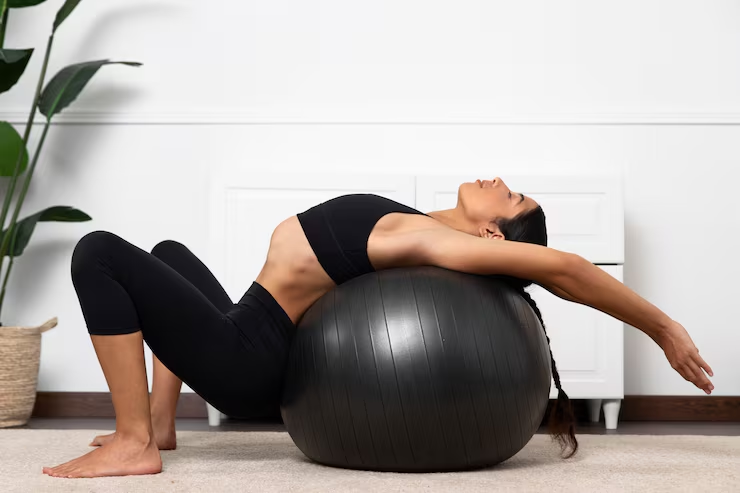
Ball pike roll-ins are a challenging core-focused exercise that targets the shoulders, abs, and hip flexors while improving overall balance. Begin in a plank position with your feet resting firmly on a stability ball and your hands placed directly under your shoulders. Keep your body in a straight line from head to heels, engaging your core to stabilize the position before starting the movement. Proper alignment is key to avoiding strain and maximizing results.
To perform the exercise, contract your abdominal muscles and lift your hips toward the ceiling, rolling the ball toward your chest. Your body should form an inverted “V” position at the peak of the movement. Slowly return to the starting plank position, maintaining control to engage the core fully. Aim for 8–12 repetitions per set, focusing on smooth, controlled motions rather than speed.
This challenging movement elevates heart rate, burns calories, and builds exceptional core strength. It improves balance and flexibility while targeting deep abdominal muscles. Over time, ball pike roll-ins enhance overall athletic performance and fat-burning capacity.
Benefits: Strengthens core, shoulders, and hip flexors; burns high calories; improves flexibility and full-body stability.
Ingredients/Tools: Stability ball for foot placement, non-slip mat for added grip, and breathable activewear to allow a full range of motion.
Tips to Maximize Results from Ball Exercises
To achieve the best fat-burning effect, it’s essential to pair ball exercises with a balanced diet that includes lean proteins, fiber-rich vegetables, and healthy fats. Proper nutrition fuels your body, supports muscle repair, and enhances metabolism. Avoid processed foods and sugary drinks, as they can slow down fat loss. Eating a light pre-workout snack, like a banana or protein smoothie, provides energy for an intense session while aiding endurance.
Incorporating interval training into your routine can dramatically increase calorie burn. Alternate high-intensity moves, such as medicine ball slams or pike roll-ins, with strength-based exercises like ball squats or bridges. This combination keeps your heart rate elevated, boosts metabolism, and promotes fat burning long after the workout ends. Begin with shorter intervals, then gradually increase duration as your stamina improves.
For maximum results, focus on form and consistency. Perform 45–60 minute sessions at least three times a week. Take short rest periods, stay hydrated, and listen to your body to avoid injury. Over time, these habits enhance strength, balance, and overall weight loss.
Conclusion
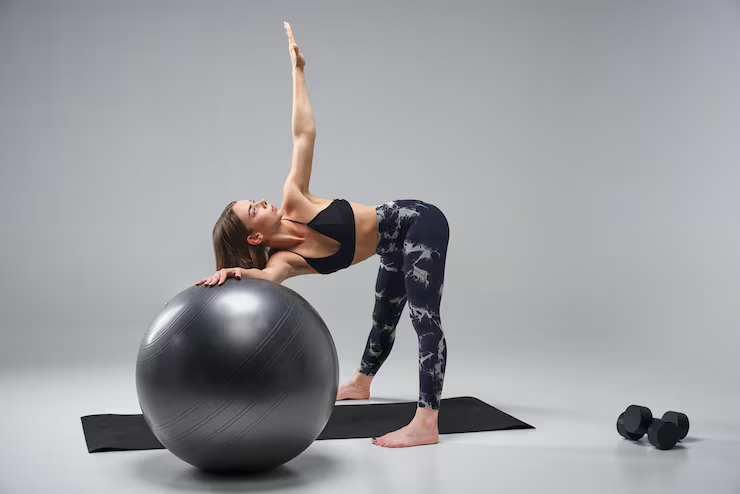
Ball exercise for weight loss is a versatile and enjoyable way to shed pounds while strengthening the entire body. By incorporating a stability or medicine ball into daily workouts, you can burn calories efficiently while toning muscles.
A consistent ball exercise for weight loss routine enhances balance, flexibility, and metabolism. Whether you are a beginner or an advanced fitness enthusiast, ball exercises can be customized to match your goals.
Start slowly, focus on proper form, and gradually increase intensity. When paired with a balanced diet and regular hydration, a ball exercise for weight loss plan can lead to lasting fat loss, improved fitness, and greater confidence.
FAQs
1. How often should I do ball exercises for weight loss?
Perform ball exercises 3–5 times a week with cardio and a balanced diet to boost metabolism and burn fat effectively.
2. Can beginners do these exercises?
Yes, start with simple moves like ball squats or bridges, then increase reps or intensity as balance and strength improve.
3. How soon will I see results?
Visible fat loss and muscle tone typically appear within 4–6 weeks of consistent workouts.
4. What equipment is required?
A stability or medicine ball, yoga mat, supportive shoes, and optional dumbbells enhance safety and results.
5. Do these exercises reduce belly fat?
Yes, core-focused moves like planks, ball pass crunches, and Russian twists target abdominal fat, strengthen muscles, and improve overall fat burning.
